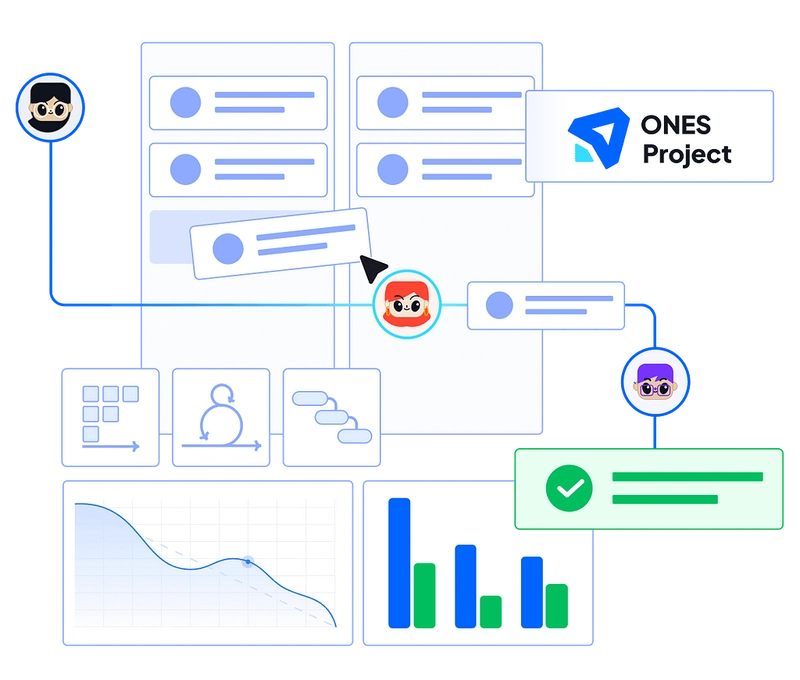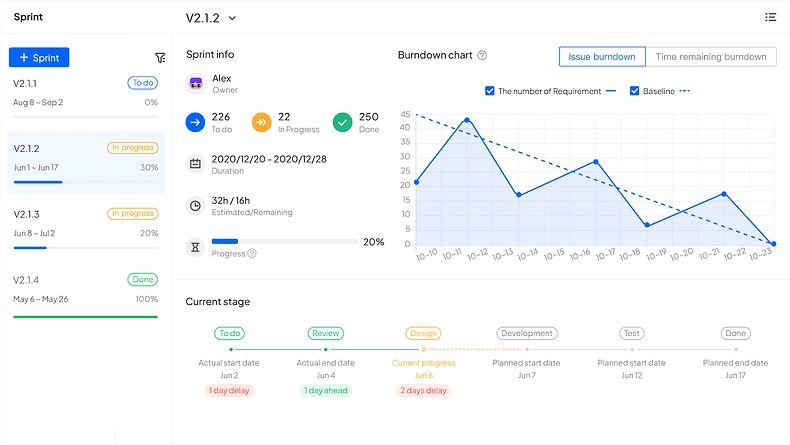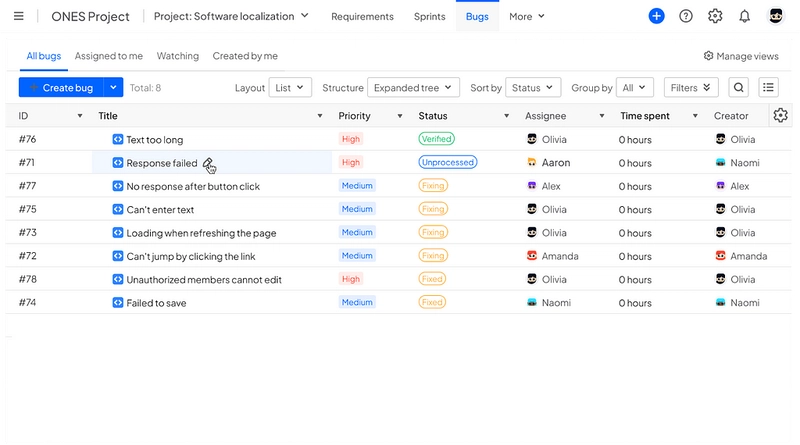Large-scale agile projects with several teams working together in parallel can get as scary as piercing your ears using paper-cutting scissors. Project management is no easy task. Especially in present dynamics, where companies form a team that is highly diverse in nature, often remotely located, and working in different timezones.
To successfully deliver a project within the set time & budget constraints, teams need to be in sync. They need to be aligned with the project plan. And that’s where the project management workflow kicks in.
Read this insight to understand:
- What’s a project management workflow?
- How agile project management’s workflow is different from traditional project workflow?
- How to create an agile project management workflow?
What is a project management workflow?
- Project management workflow is a sequential flow of activities, in line with the requirement list of the product which is to be developed.
- The project management workflow also represents dependency relationships between different sequential activities and the types of relationships.
- The workflow also estimates and reflects talent, time & cost estimation for each activity, and allocates resources for the same.
Lastly, an effective and efficient project management workflow will also have a critical path that runs through all the product’s critical features, which must be developed flawlessly in a timely fashion.
Traditional vs Agile project management workflow
Traditional Project Management Workflow
- Traditional project management workflow is like a high-level skeleton of the processes involved in specific product development like — planning, executing the plans, controlling tasks & escalations etcetera to arrive at the desired goal. It’s not highly detailed.
- Traditional project management workflow is suited to projects with clear scope & requirements, and projects with linear processes i.e., processes can be executed one after the other in a pre-planned sequence.
- Traditional project management workflow includes — initiation, planning, execution, Monitoring, and Closing.
- Traditional project management workflow faces rigidity challenges, and it almost has negligible customer involvement or feedback.
Agile Project Management Workflow
- Agile workflow on the other hand is highly detailed. From sprint phases to time estimates for each of the features, resource availability, and every minute aspect is detailed in an agile workflow.
- Agile project management workflow is suited for projects with evolving requirements, and non-linear processes i.e., projects that are highly unpredictable. Esp, complex projects which need iterative & flexible development environments are best planned with agile project workflows.
- Agile project management workflow includes — ideation, iteration, production, release, and Maintenance
- Agile projects are flexible, but costs can often spike if the project is mismanaged. Generally, there is little to no documentation for overall product functioning as the project is shipped in fragments over continuous delivery cycles.
How do I create an agile project management workflow?
A robust agile project management workflow is the secret sauce of any team that excels at product development. Project management workflows help the team be organized, and improve efficiency, productivity, visibility, and accountability toward the product under development.
But how do you create an agile project management workflow?
Well, you can do it on paper and pen, a big chart paper, or a whiteboard, or you can use a project management tool — maybe a SaaS tool. It totally depends on your convenience, but using tools like ONES Project streamlines the project management tasks.
Here’s a step-by-step guide for creating effective agile workflows:
1. A comprehensive list of tasks: Descriptive project workflow
Prepare a sequential list of all the features that your team needs to complete in order to successfully deliver the project. This would include literally ‘all’ the tasks. From interviewing stakeholders & end-customers to hiring talent, and knowledge transfer (KT) sessions, everything.
For example, for a website development project, the comprehensive list of tasks could be-
- Prepare a website feature requirement list
- Prioritize requirement list
- Make estimations for time, resources, and cost
- Form a team capable of delivering the website
- Design wireframes
- UX design
- UI design
- UI development
- Backend development
- UI-backend integration
- QA testing
- Daily scrum meetings
- Raising invoices periodically
- Bug fixing
- Deploying to production
- Maintenance
- Knowledge transfer to the maintenance team
Now, it’s obvious that in agile project management this list won’t be final. You can always revisit this to modify & update it. While preparing this task list, do keep in mind the flexibility factor. The tool you are using or the document you are using for this list must have enough flexibility to accommodate changes. Else, you will be wasting extra time re-writing the task list.
Anyway, the takeaway of the first step is that ‘making a comprehensive list helps better plan for its execution.
2. Visual Project workflow: Mapping the items in the task list
This is a visual version of the above list where you establish the relationships & dependencies between two or more task list items. Accordingly, you prioritize & plan the sequencing in which the features will be developed.
Again, keep in mind that the workflow should not be designed to be rigid. Agile project workflows are always designed with a flexibility-first mindset. The visual project workflow should clearly define the project starting point, essential milestones, teams who will be working on individual or set of features, the tools & resources required, the timeline, crisis management manager/team, and any other resources that might be helpful to the team.
Also, once the visual workflow is ready, it’s sensible to hold a meeting for all stakeholders. In this meeting, you can make adjustments to the project workflow if needed, or else take a go-ahead from the stakeholders. It is recommended to use a SaaS tool for this step (very effective for remote teams).
3. Make the workflow efficient & maximize the impact
80% of the tasks required for designing the project management workflow are done in the above two steps. This and the next steps are to ensure the effectiveness of the workflow. In order to boost the efficacy of the project management visual workflow, which you designed in step 2, you can label each of the steps in the workflow as critical, urgent, nice to have, or redundant. Remove any unwanted steps/features.
Especially, see if you can cut loose the workflow steps that you may have marked as redundant. Next, mark the points in the workflow where you spot, predict, or expect any sort of critical vulnerabilities, bottlenecks, or inefficiencies. Brainstorm, and pull resources to fix these loopholes. Lastly, identify the sections of the project workflow that you can automate. This will help save a lot of human hours, which can be utilized for executing the remaining parts of the project workflow to maximize the adherence to cost & time estimates.
4. Deployment & iterative maintenance of the workflow
Once everything is planned out, it’s time for a kickoff meeting. Ensure all the teams and stakeholders are on the same page and there is no confusion among them. Next, kickstart the execution, and periodically keep revisiting the workflow to test it on efficiency & efficacy parameters.
The best way to do so is to check whether the project is progressing in line with the planned timeline and within budget constraints. Additionally, you can check for other project-specific KPIs to keep any false positives at bay.
For example, just developing the feature in a software project is not enough. It should work as intended as well without any bugs. Often, mobile apps crash when a user tries to use a feature, and some apps score badly on performance and speed.
So, as the project workflow progresses, to avoid any future surprises, do test the progress against project KPIs. And accordingly, iteratively keep improving the project workflow.
5. Project workflow closure
The last step of the workflow is delivering the product post rigorous quality assurance.
Design project management workflows with ONES Project
Agile, Waterfall, or Hybrid — no matter which project management methodology your project fits in, a project management workflow is common everywhere. In fact, at times there are mini agile projects within a waterfall model and vice versa.
So, the tools you use to a great extent decide the efficiency of your team. ONES Project is designed keeping in view the needs of agile, waterfall, and hybrid teams. With ONES Project, you can organize any type of project, issue, or workflow.
ONES Project is more than just another tool. You can manage product backlogs, plan sprints, design & optimize workflows using Kanban boards, and manage dependencies as the project moves through its lifecycle. The best part, it is easily integrable with your pool of existing native & third-party project management tools.
Try ONES.com for managing your agile, waterfall, or hybrid projects.
Originally published at https://blog.ones.com on December 21, 2022.








Top comments (0)
Some comments may only be visible to logged-in visitors. Sign in to view all comments.